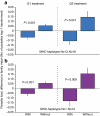Rapid and adaptive evolution of MHC genes under parasite selection in experimental vertebrate populations
- PMID: 22233631
- PMCID: PMC3272583
- DOI: 10.1038/ncomms1632
Rapid and adaptive evolution of MHC genes under parasite selection in experimental vertebrate populations
Abstract
The genes of the major histocompatibility complex are the most polymorphic genes in vertebrates, with more than 1,000 alleles described in human populations. How this polymorphism is maintained, however, remains an evolutionary puzzle. Major histocompatibility complex genes have a crucial function in the adaptive immune system by presenting parasite-derived antigens to T lymphocytes. Because of this function, varying parasite-mediated selection has been proposed as a major evolutionary force for maintaining major histocompatibility complex polymorphism. A necessary prerequisite of such a balancing selection process is rapid major histocompatibility complex allele frequency shifts resulting from emerging selection by a specific parasite. Here we show in six experimental populations of sticklebacks, each exposed to one of two different parasites, that only those major histocompatibility complex alleles providing resistance to the respective specific parasite increased in frequency in the next host generation. This result demonstrates experimentally that varying parasite selection causes rapid adaptive evolutionary changes, thus facilitating the maintenance of major histocompatibility complex polymorphism.
Figures



Similar articles
-
Selection from parasites favours immunogenetic diversity but not divergence among locally adapted host populations.J Evol Biol. 2014 May;27(5):960-74. doi: 10.1111/jeb.12370. Epub 2014 Apr 12. J Evol Biol. 2014. PMID: 24725091
-
Does the parasite-mediated selection drive the MHC class IIB diversity in wild populations of European chub (Squalius cephalus)?Parasitol Res. 2016 Apr;115(4):1401-15. doi: 10.1007/s00436-015-4874-4. Epub 2015 Dec 23. Parasitol Res. 2016. PMID: 26693717
-
Balancing selection and heterozygote advantage in major histocompatibility complex loci of the bottlenecked Finnish wolf population.Mol Ecol. 2014 Feb;23(4):875-89. doi: 10.1111/mec.12647. Mol Ecol. 2014. PMID: 24382313
-
Advances in the Evolutionary Understanding of MHC Polymorphism.Trends Genet. 2020 Apr;36(4):298-311. doi: 10.1016/j.tig.2020.01.008. Epub 2020 Feb 7. Trends Genet. 2020. PMID: 32044115 Review.
-
Major Histocompatibility Complex (MHC) Genes and Disease Resistance in Fish.Cells. 2019 Apr 25;8(4):378. doi: 10.3390/cells8040378. Cells. 2019. PMID: 31027287 Free PMC article. Review.
Cited by
-
Rapid evolution of parasite resistance in a warmer environment: insights from a large scale field experiment.PLoS One. 2015 Jun 2;10(6):e0128860. doi: 10.1371/journal.pone.0128860. eCollection 2015. PLoS One. 2015. PMID: 26035300 Free PMC article.
-
Genetic slippage after sex maintains diversity for parasite resistance in a natural host population.Sci Adv. 2022 Nov 16;8(46):eabn0051. doi: 10.1126/sciadv.abn0051. Epub 2022 Nov 18. Sci Adv. 2022. PMID: 36399570 Free PMC article.
-
Major histocompatibility complex variation is similar in little brown bats before and after white-nose syndrome outbreak.Ecol Evol. 2020 Aug 31;10(18):10031-10043. doi: 10.1002/ece3.6662. eCollection 2020 Sep. Ecol Evol. 2020. PMID: 33005361 Free PMC article.
-
Immunogenetic variation shapes the gut microbiome in a natural vertebrate population.Microbiome. 2022 Mar 8;10(1):41. doi: 10.1186/s40168-022-01233-y. Microbiome. 2022. PMID: 35256003 Free PMC article.
-
Immunogenetic response of the bananaquit in the face of malarial parasites.BMC Evol Biol. 2019 May 22;19(1):107. doi: 10.1186/s12862-019-1435-y. BMC Evol Biol. 2019. PMID: 31113360 Free PMC article.
References
-
- Robinson J. et al.. The IMGT/HLA database. Nucleic Acids Res. 37, 1013–1017 (2009). - PubMed
-
- Janeway C. A., Travers P., Walport M. & Sclomchik M. J. Immunobiology: the Immune System in Health and Disease 6th edn (Garland Science, 2005).
-
- Bernatchez L. & Landry C. MHC studies in nonmodel vertebrates: what have we learned about natural selection in 15 years? J. Evol. Biol. 16, 363–377 (2003). - PubMed
-
- Barrett R. D. H. & Schluter D. Adaptation from standing genetic variation. Trends Ecol. Evol. 23, 38–44 (2008). - PubMed
MeSH terms
LinkOut - more resources
Full Text Sources
Medical
Research Materials

